ECU KIA Sportage 2008 JE_ / 2.G Owner's Guide
[x] Cancel search | Manufacturer: KIA, Model Year: 2008, Model line: Sportage, Model: KIA Sportage 2008 JE_ / 2.GPages: 350, PDF Size: 6.42 MB
Page 93 of 350
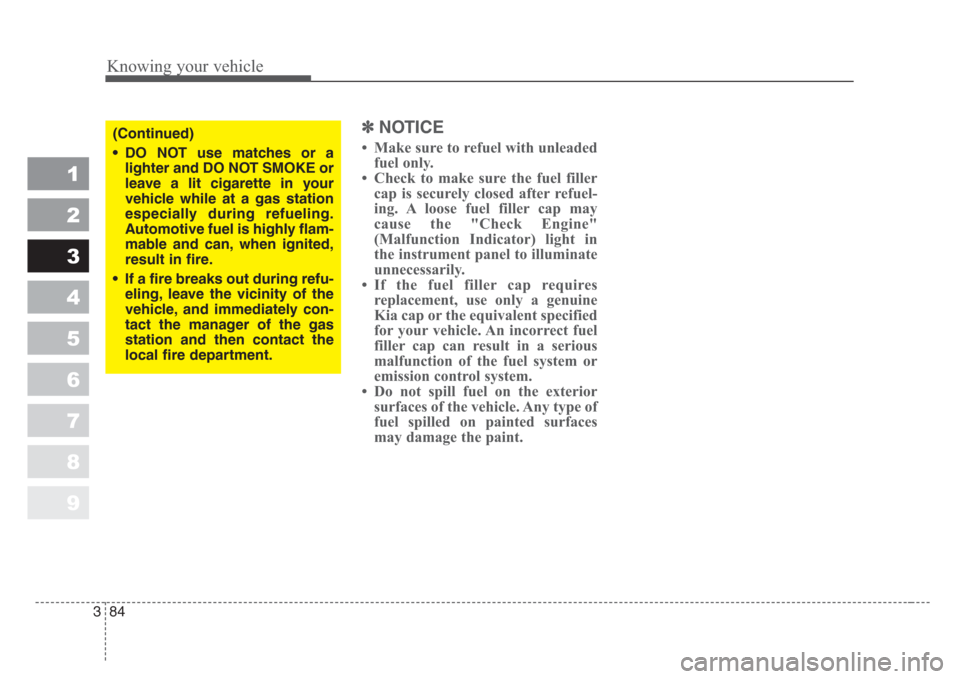
Knowing your vehicle
84 3
1
2
3
4
5
6
7
8
9
✽
NOTICE
• Make sure to refuel with unleaded
fuel only.
• Check to make sure the fuel filler
cap is securely closed after refuel-
ing. A loose fuel filler cap may
cause the "Check Engine"
(Malfunction Indicator) light in
the instrument panel to illuminate
unnecessarily.
• If the fuel filler cap requires
replacement, use only a genuine
Kia cap or the equivalent specified
for your vehicle. An incorrect fuel
filler cap can result in a serious
malfunction of the fuel system or
emission control system.
• Do not spill fuel on the exterior
surfaces of the vehicle. Any type of
fuel spilled on painted surfaces
may damage the paint.
(Continued)
• DO NOT use matches or a
lighter and DO NOT SMOKE or
leave a lit cigarette in your
vehicle while at a gas station
especially during refueling.
Automotive fuel is highly flam-
mable and can, when ignited,
result in fire.
• If a fire breaks out during refu-
eling, leave the vicinity of the
vehicle, and immediately con-
tact the manager of the gas
station and then contact the
local fire department.
Page 100 of 350
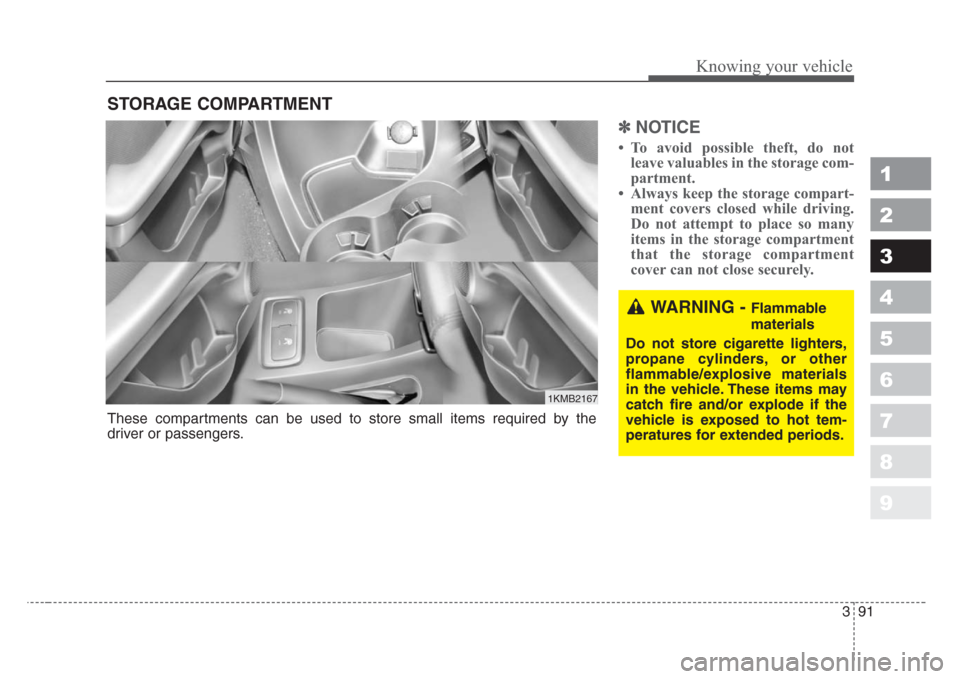
391
1
2
3
4
5
6
7
8
9
Knowing your vehicle
✽
NOTICE
• To avoid possible theft, do not
leave valuables in the storage com-
partment.
• Always keep the storage compart-
ment covers closed while driving.
Do not attempt to place so many
items in the storage compartment
that the storage compartment
cover can not close securely.
STORAGE COMPARTMENT
WARNING - Flammable
materials
Do not store cigarette lighters,
propane cylinders, or other
flammable/explosive materials
in the vehicle.These items may
catch fire and/or explode if the
vehicle is exposed to hot tem-
peratures for extended periods.
These compartments can be used to store small items required by the
driver or passengers.
1KMB2167
Page 104 of 350
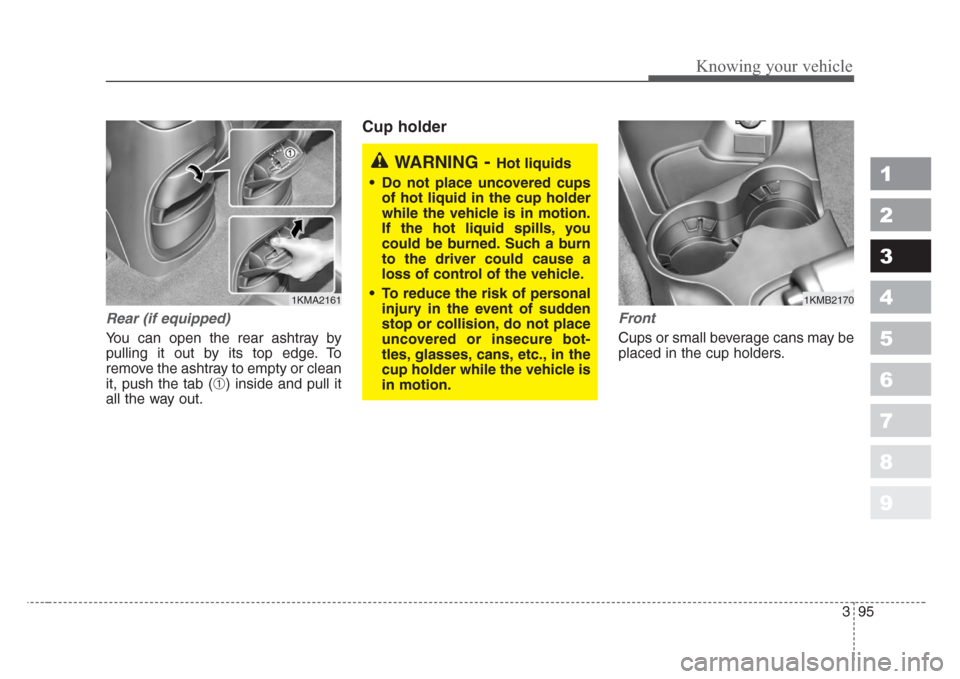
395
1
2
3
4
5
6
7
8
9
Knowing your vehicle
Rear (if equipped)
You can open the rear ashtray by
pulling it out by its top edge. To
remove the ashtray to empty or clean
it, push the tab (
➀) inside and pull it
all the way out.
Cup holder
Front
Cups or small beverage cans may be
placed in the cup holders.
1KMA2161
WARNING-Hot liquids
• Do not place uncovered cups
of hot liquid in the cup holder
while the vehicle is in motion.
If the hot liquid spills,you
could be burned.Such a burn
to the driver could cause a
loss of control of the vehicle.
• To reduce the risk of personal
injury in the event of sudden
stop or collision, do not place
uncovered or insecure bot-
tles,glasses, cans,etc.,in the
cup holder while the vehicle is
in motion.
1KMB2170
Page 106 of 350
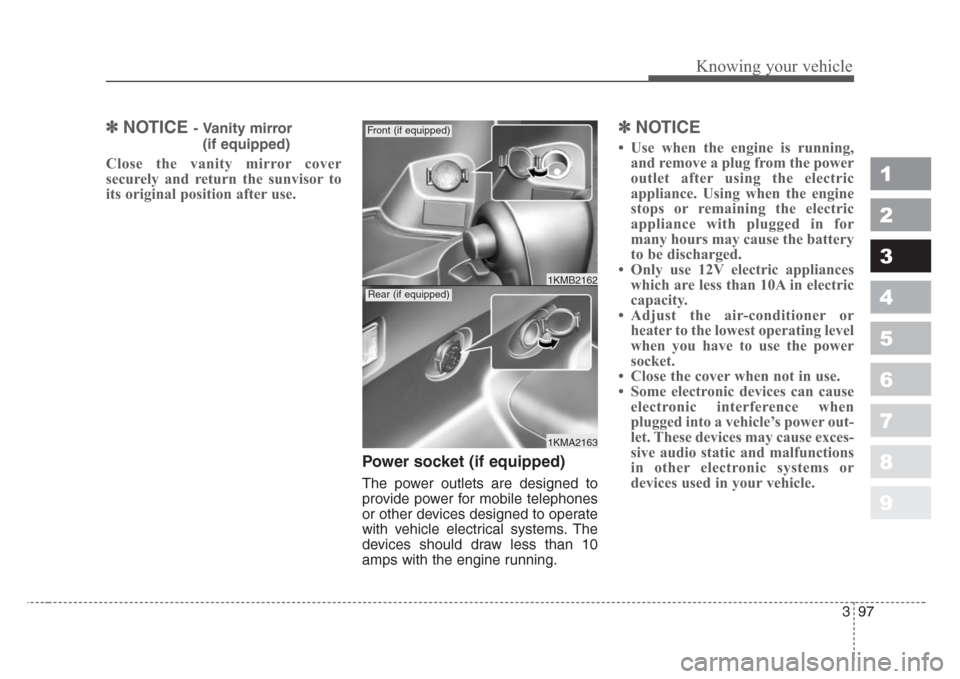
397
1
2
3
4
5
6
7
8
9
Knowing your vehicle
✽
NOTICE - Vanity mirror
(if equipped)
Close the vanity mirror cover
securely and return the sunvisor to
its original position after use.
Power socket (if equipped)
The power outlets are designed to
provide power for mobile telephones
or other devices designed to operate
with vehicle electrical systems. The
devices should draw less than 10
amps with the engine running.
✽
NOTICE
• Use when the engine is running,
and remove a plug from the power
outlet after using the electric
appliance. Using when the engine
stops or remaining the electric
appliance with plugged in for
many hours may cause the battery
to be discharged.
• Only use 12V electric appliances
which are less than 10A in electric
capacity.
• Adjust the air-conditioner or
heater to the lowest operating level
when you have to use the power
socket.
• Close the cover when not in use.
• Some electronic devices can cause
electronic interference when
plugged into a vehicle’s power out-
let. These devices may cause exces-
sive audio static and malfunctions
in other electronic systems or
devices used in your vehicle.
1KMA2163
1KMB2162
Front (if equipped)
Rear (if equipped)
Page 117 of 350
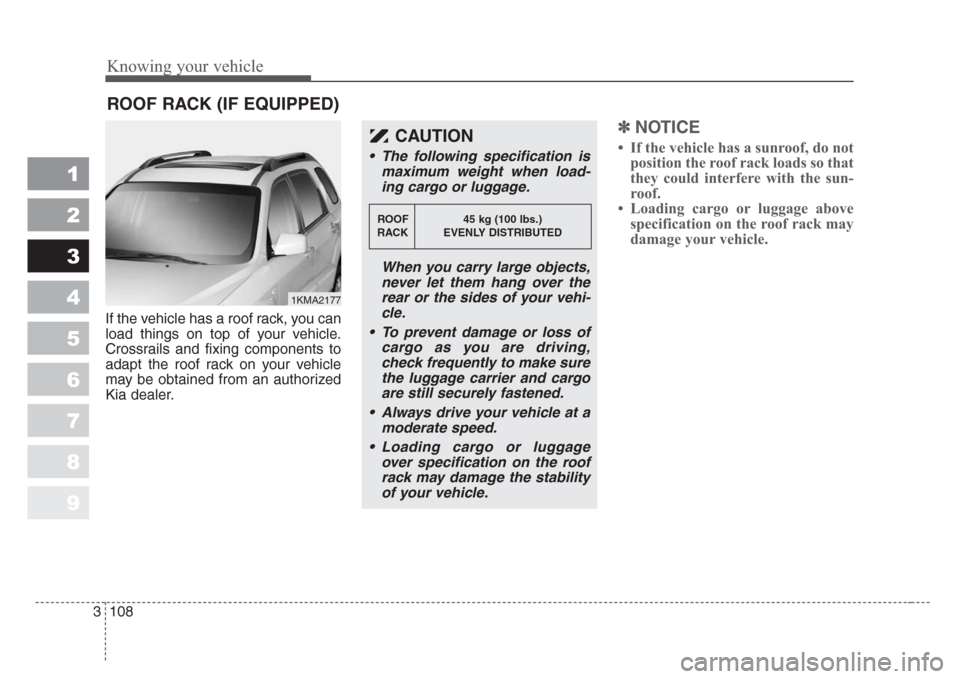
Knowing your vehicle
108 3
1
2
3
4
5
6
7
8
9
If the vehicle has a roof rack, you can
load things on top of your vehicle.
Crossrails and fixing components to
adapt the roof rack on your vehicle
may be obtained from an authorized
Kia dealer.
✽
NOTICE
• If the vehicle has a sunroof, do not
position the roof rack loads so that
they could interfere with the sun-
roof.
• Loading cargo or luggage above
specification on the roof rack may
damage your vehicle.
ROOF RACK (IF EQUIPPED)
1KMA2177
CAUTION
• The following specification is
maximum weight when load-
ing cargo or luggage.
When you carry large objects,
never let them hang over the
rear or the sides of your vehi-
cle.
• To prevent damage or loss of
cargo as you are driving,
check frequently to make sure
the luggage carrier and cargo
are still securely fastened.
•Always drive your vehicle at a
moderate speed.
• Loading cargo or luggage
over specification on the roof
rack may damage the stability
of your vehicle.
ROOF 45 kg (100 lbs.)
RACK EVENLY DISTRIBUTED
Page 128 of 350
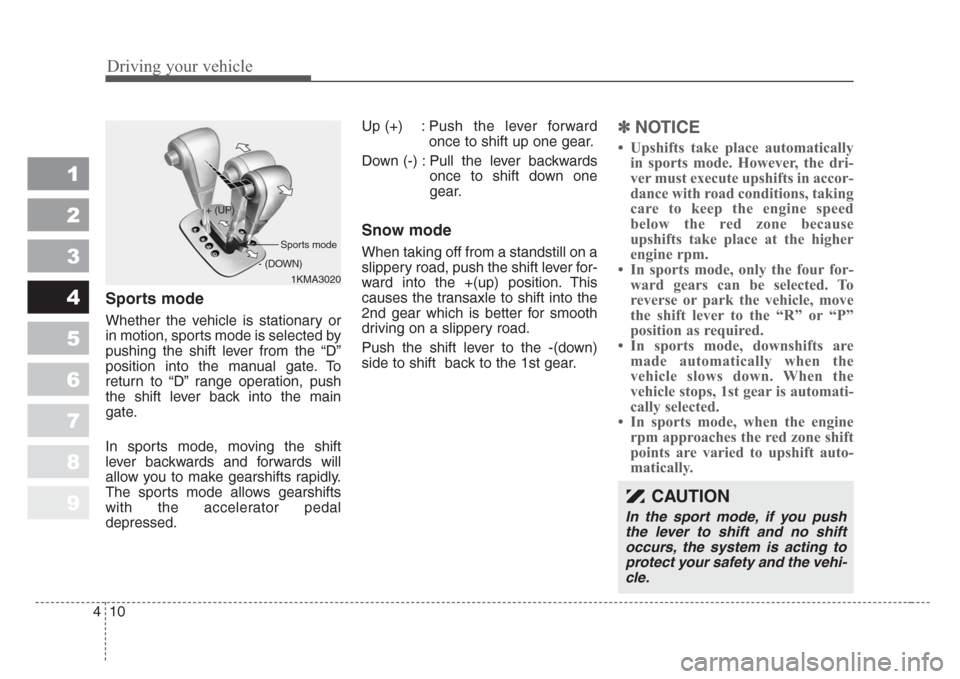
Driving your vehicle
10 4
1
2
3
4
5
6
7
8
9
Sports mode
Whether the vehicle is stationary or
in motion, sports mode is selected by
pushing the shift lever from the “D”
position into the manual gate. To
return to “D” range operation, push
the shift lever back into the main
gate.
In sports mode, moving the shift
lever backwards and forwards will
allow you to make gearshifts rapidly.
The sports mode allows gearshifts
with the accelerator pedal
depressed.Up (+) : Push the lever forward
once to shift up one gear.
Down (-) : Pull the lever backwards
once to shift down one
gear.
Snow mode
When taking off from a standstill on a
slippery road, push the shift lever for-
ward into the +(up) position. This
causes the transaxle to shift into the
2nd gear which is better for smooth
driving on a slippery road.
Push the shift lever to the -(down)
side to shift back to the 1st gear.
✽
NOTICE
• Upshifts take place automatically
in sports mode. However, the dri-
ver must execute upshifts in accor-
dance with road conditions, taking
care to keep the engine speed
below the red zone because
upshifts take place at the higher
engine rpm.
• In sports mode, only the four for-
ward gears can be selected. To
reverse or park the vehicle, move
the shift lever to the “R” or “P”
position as required.
• In sports mode, downshifts are
made automatically when the
vehicle slows down. When the
vehicle stops, 1st gear is automati-
cally selected.
• In sports mode, when the engine
rpm approaches the red zone shift
points are varied to upshift auto-
matically.
1KMA3020 + (UP)
- (DOWN)
Sports mode
CAUTION
In the sport mode,if you push
the lever to shift and no shift
occurs, the system is acting to
protect your safety and the vehi-
cle.
Page 138 of 350
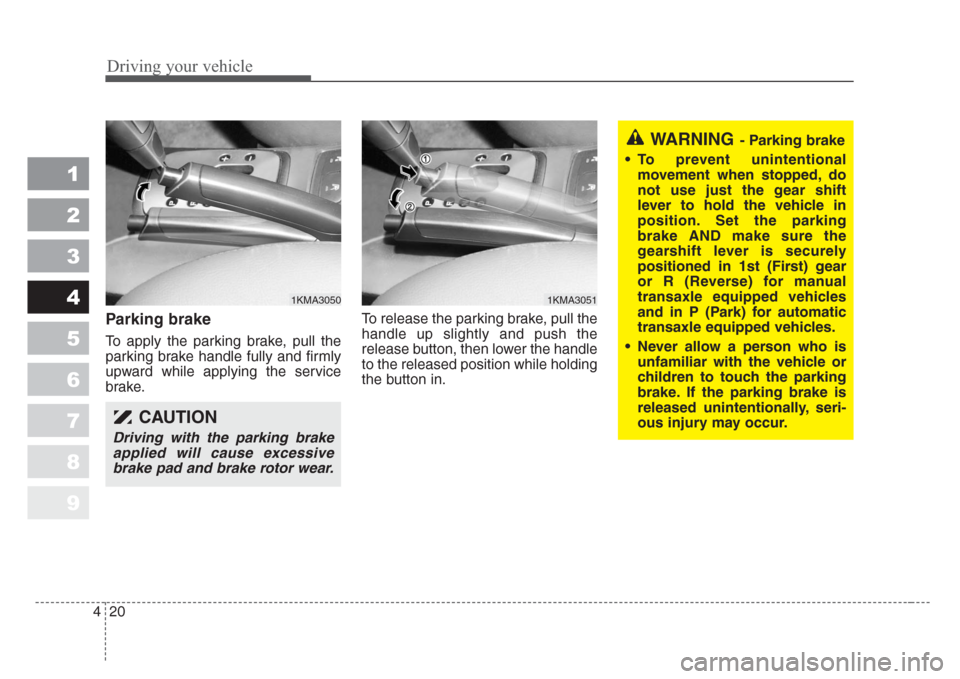
Driving your vehicle
20 4
1
2
3
4
5
6
7
8
9
Parking brake
To apply the parking brake, pull the
parking brake handle fully and firmly
upward while applying the service
brake.To release the parking brake, pull the
handle up slightly and push the
release button, then lower the handle
to the released position while holding
the button in.
CAUTION
Driving with the parking brake
applied will cause excessive
brake pad and brake rotor wear.
1KMA30501KMA3051
WARNING- Parking brake
• To prevent unintentional
movement when stopped, do
not use just the gear shift
lever to hold the vehicle in
position.Set the parking
brake AND make sure the
gearshift lever is securely
positioned in 1st (First) gear
or R (Reverse) for manual
transaxle equipped vehicles
and in P (Park) for automatic
transaxle equipped vehicles.
• Never allow a person who is
unfamiliar with the vehicle or
children to touch the park
ing
brake.If the parking brake is
released unintentionally,seri-
ous injury may occur.
Page 167 of 350
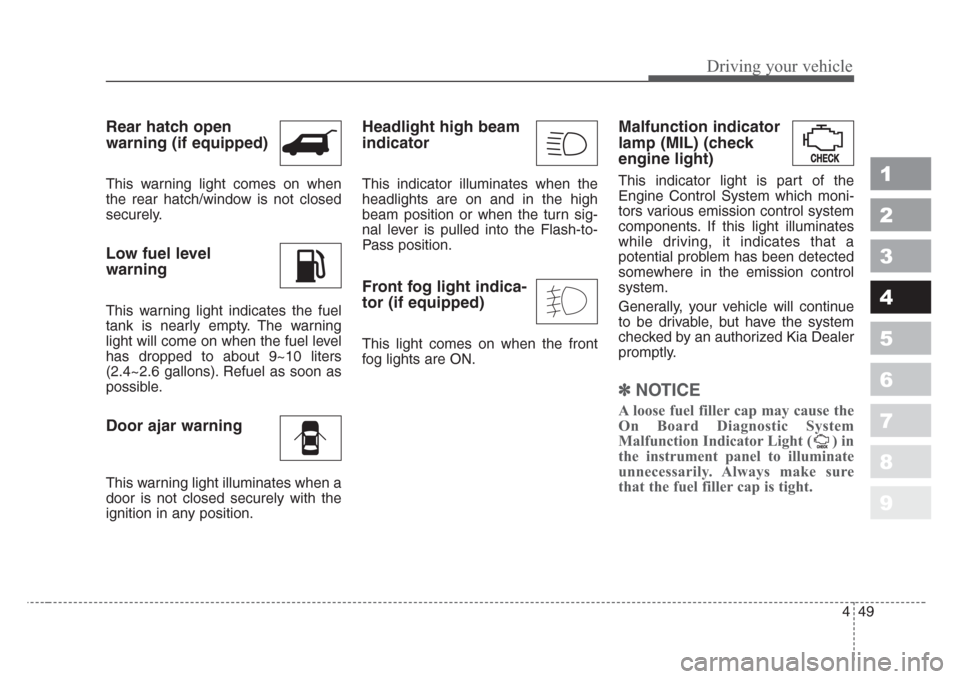
449
Driving your vehicle
1
2
3
4
5
6
7
8
9
Rear hatch open
warning (if equipped)
This warning light comes on when
the rear hatch/window is not closed
securely.
Low fuel level
warning
This warning light indicates the fuel
tank is nearly empty. The warning
light will come on when the fuel level
has dropped to about 9~10 liters
(2.4~2.6 gallons). Refuel as soon as
possible.
Door ajar warning
This warning light illuminates when a
door is not closed securely with the
ignition in any position.
Headlight high beam
indicator
This indicator illuminates when the
headlights are on and in the high
beam position or when the turn sig-
nal lever is pulled into the Flash-to-
Pass position.
Front fog light indica-
tor (if equipped)
This light comes on when the front
fog lights are ON.
Malfunction indicator
lamp (MIL) (check
engine light)
This indicator light is part of the
Engine Control System which moni-
tors various emission control system
components. If this light illuminates
while driving, it indicates that a
potential problem has been detected
somewhere in the emission control
system.
Generally, your vehicle will continue
to be drivable, but have the system
checked by an authorized Kia Dealer
promptly.
✽
NOTICE
A loose fuel filler cap may cause the
On Board Diagnostic System
Malfunction Indicator Light ( ) in
the instrument panel to illuminate
unnecessarily. Always make sure
that the fuel filler cap is tight.
Page 226 of 350
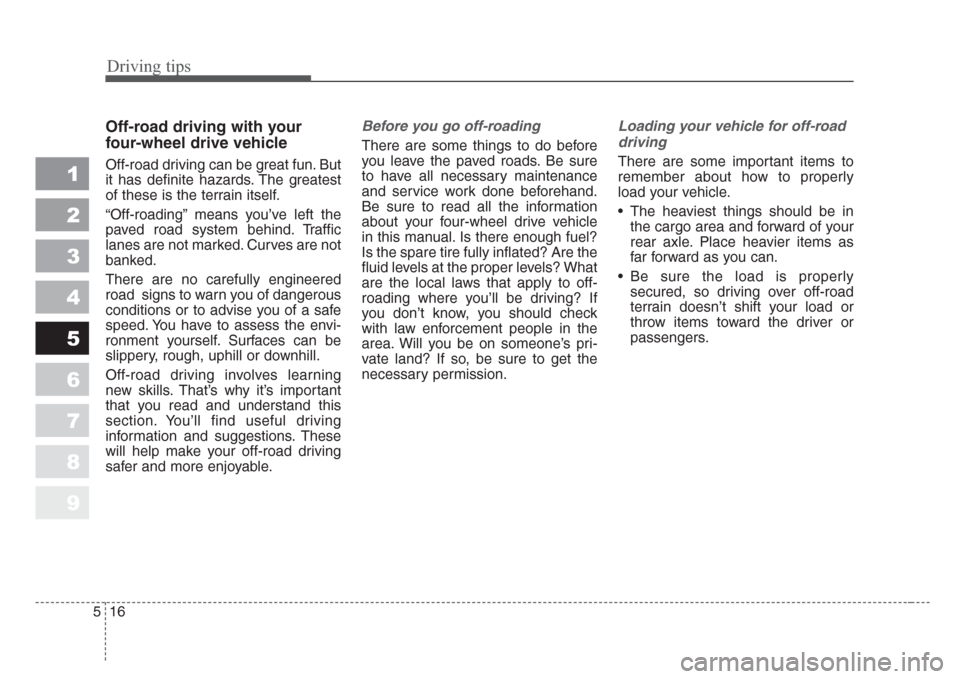
Driving tips
16 5
1
2
3
4
5
6
7
8
9
Off-road driving with your
four-wheel drive vehicle
Off-road driving can be great fun. But
it has definite hazards. The greatest
of these is the terrain itself.
“Off-roading” means you’ve left the
paved road system behind. Traffic
lanes are not marked. Curves are not
banked.
There are no carefully engineered
road signs to warn you of dangerous
conditions or to advise you of a safe
speed. You have to assess the envi-
ronment yourself. Surfaces can be
slippery, rough, uphill or downhill.
Off-road driving involves learning
new skills. That’s why it’s important
that you read and understand this
section. You’ll find useful driving
information and suggestions. These
will help make your off-road driving
safer and more enjoyable.
Before you go off-roading
There are some things to do before
you leave the paved roads. Be sure
to have all necessary maintenance
and service work done beforehand.
Be sure to read all the information
about your four-wheel drive vehicle
in this manual. Is there enough fuel?
Is the spare tire fully inflated? Are the
fluid levels at the proper levels? What
are the local laws that apply to off-
roading where you’ll be driving? If
you don’t know, you should check
with law enforcement people in the
area. Will you be on someone’s pri-
vate land? If so, be sure to get the
necessary permission.
Loading your vehicle for off-road
driving
There are some important items to
remember about how to properly
load your vehicle.
• The heaviest things should be in
the cargo area and forward of your
rear axle. Place heavier items as
far forward as you can.
• Be sure the load is properly
secured, so driving over off-road
terrain doesn’t shift your load or
throw items toward the driver or
passengers.
Page 227 of 350
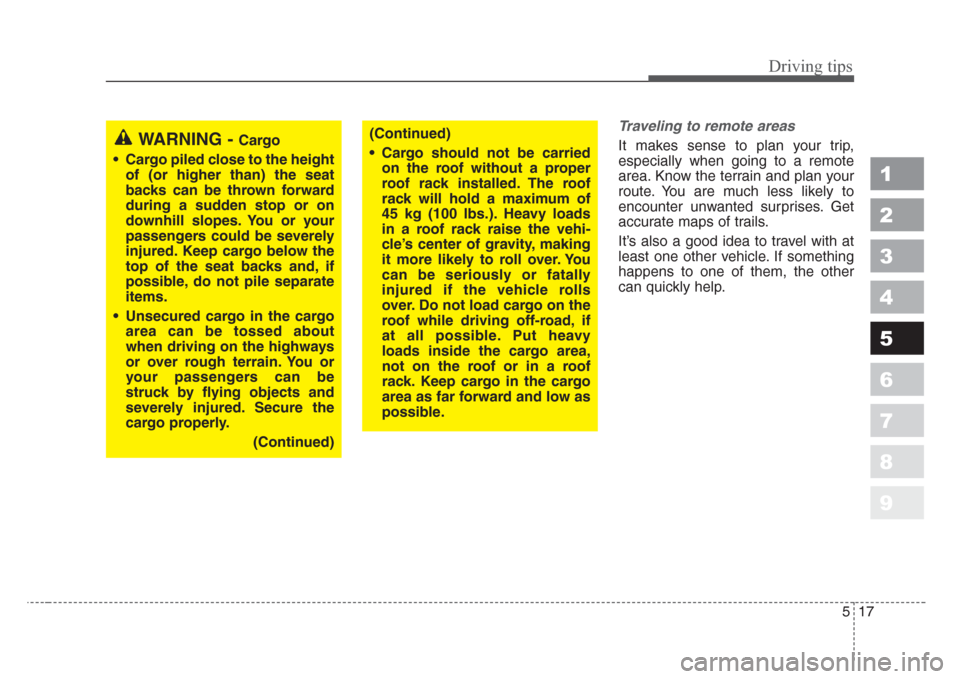
517
Driving tips
1
2
3
4
5
6
7
8
9
Traveling to remote areas
It makes sense to plan your trip,
especially when going to a remote
area. Know the terrain and plan your
route. You are much less likely to
encounter unwanted surprises. Get
accurate maps of trails.
It’s also a good idea to travel with at
least one other vehicle. If something
happens to one of them, the other
can quickly help.WARNING - Cargo
• Cargo piled close to the height
of (or higher than) the seat
backs can be thrown forward
during a sudden stop or on
downhill slopes.You or your
passengers could be severely
injured.Keep cargo below the
top of the seat backs and,if
possible, do not pile separate
items.
•Unsecured cargo in the cargo
area can be tossed about
when driving on the highways
or over rough terrain.You or
your passengers can be
struck by flying objects and
severely injured.
Secure the
cargo properly.
(Continued)
(Continued)
• Cargo should not be carried
on the roof without a proper
roof rack installed.The roof
rack will hold a maximum of
45 kg (100 lbs.).Heavy loads
in a roof rack raise the vehi-
cle’s center of gravity, making
it more likely to roll over.Yo u
can be seriously or fatally
injured if the vehicle rolls
over.Do not load cargo on the
roof while driving off-road,if
at all possible.Put heavy
loads inside the cargo area,
not on the roof or in a roof
rack.Keep cargo in the cargo
area as far forward and low as
po
ssible.